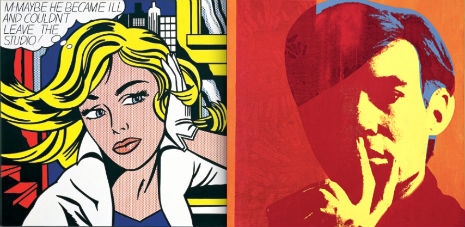
Pop Artists Roy Lichtenstein and Andy Warhol divulge some of the influences and techniques to their work in this documentary by Lane Slate from 1966.
Artists are not always the best expositors on their art. There are the exceptions like David Hockney, who inclusively shares his knowledge through television documentaries, or Francis Bacon, who spent hours in conversation with David Sylvester discussing the influences and sources for his work. Here, we find Lichtenstein enthusiastic though slightly inconclusive, and Warhol being just Andy.
Roy Lichtenstein’s bold, bright, iconic paintings of comic book panels and advertisements offered an ironic commentary on sixties’ consumer society, while at the same time showed an artist attempting to make art viable in such a world. When Lichtenstein explains the ideas and intentions behind his work, his answers come spilling out like the contents of a shaken can of cola, the bubbles of information frothing over into long stream of consciousness answers, which never really come to a formal resolution.
Lichtenstein begins with a description of the modern landscape that inspired his work and influenced his style:
”I think we’re living in a society that is to a large extent is Pop, I think it’s one of the facets of our society, and it’s one of the facets of present society which is new, and is one of the facets which hasn’t existed before.
“It’s made in a way, partially, a new landscape for us. In the way of billboards, and neon signs, and all the stuff we’re familiar with, and also literature, and television, radio, almost all of the landscape, all of our environment seems to be made, partially, of a desire to sell products.
“This is the landscape that I am interested in portraying. I’m also not only portraying it, but I am working in the style of it, or a style which at least parodies the style of everyday art, everyday society.
“I am interested in portraying a sort of anti-sensibility that pervades the society and a maybe gross over-simplification. I use that more as style rather than actuality. I really don’t think art can be gross and over-simplified and remain art—it must have subtleties, and it must sort of yield to an aesthetic unity, otherwise it’s not in the realm of art, it’s something else probably. But I think using it as a style gives it a kind of brutality, and maybe hostility that is useful to me in an aesthetic way.”
Okay, Roy.
Andy Warhol starts his interview with a renunciation of the reverence with which art and paintings are given.
”Why I don’t paint anything? Because I hate objects. I hate to go to museums to see pictures on walls that look so important because they don’t mean anything, I think.”
It’s a good start, as Warhol could give a masterclass in being inarticulate. Of course, it’s all deliberately elusive, and just watch how quickly he loses interest once the questions become about the personal rather than his work.
“You should just tell me the words and I’ll repeat them. I’m so empty today, I can’t think of anything.”
The interview ends with Warhol talking about The Velvet Underground, before he is seen inflating silver balloons as the band rehearse in the background.